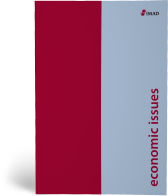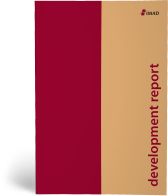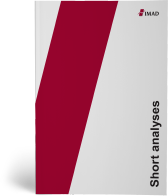Productivity and competitiveness
In its role as Slovenia’s national productivity board, IMAD conducts analyses and provides recommendations to improve productivity. For many years, these analyses were an integral part of IMAD’s regular publications. From 2019 to 2025, they were published separately as annual reports. In addition to a detailed overview of trends, the analyses examine the key drivers and conditions for increasing productivity and competitiveness, such as investment, innovation, digital transformation and knowledge, social and institutional capital, and the transition to a low-carbon circular economy. As of 2025, these topics have been incorporated into the publication Quality of Life in Slovenia – Development Report, which now addresses both development and productivity—the latter being a critical long-term factor for improving quality of life.
Economic Issues 2016
Economic Issues has been dealing with topics that require an economic policy response since its first edition in 2007. This year’s publication focuses on fiscal policy and developments as well as responses to demographic change in Slovenia. We also prepared international conference about the topics.
Development Report 2017
Following the setback during the crisis, Slovenia has been making progress in terms of economic development and the welfare of its population in recent years; it has also reduced pressures on the environment. Since 2014 the economic picture has been improving, and Slovenia is again catching up with economically more advanced countries. The recovery has led to an overall improvement in the material…
Development Report 2016
In the past few years, Slovenia has taken a number of positive steps and slightly narrowed its development gap with the EU. Regardless of positive shifts, challenges remain in terms of ensuring a more sustainable improvement to Slovenia’s growth potential and the welfare of its population, which will require more radical structural changes.
Assessing the Effects of Some Structural Measures in Slovenia
According to IMAD analyses, structural imbalances in Slovenia have been accumulating for several years, impeding economic recovery and, in particular, the achievement of lasting and stable economic growth and long-term fiscal sustainability.
Development Report 2016
In the past few years, Slovenia has taken a number of positive steps and slightly narrowed its development gap with the EU. Regardless of these positive shifts, challenges remain in terms of ensuring a more sustainable improvement to Slovenia’s growth potential and the welfare of its population, which will require more radical structural changes.
Development Report 2015
The year 2014 was marked by positive shifts in terms of economic development, the deterioration in the material position of households was halted, while pressures on the environment eased during the crisis, mainly under the influence of weak economic activity. To ensure more permanent economic growth and sustainable convergence to more developed countries, and to maintain the quality of life and…



